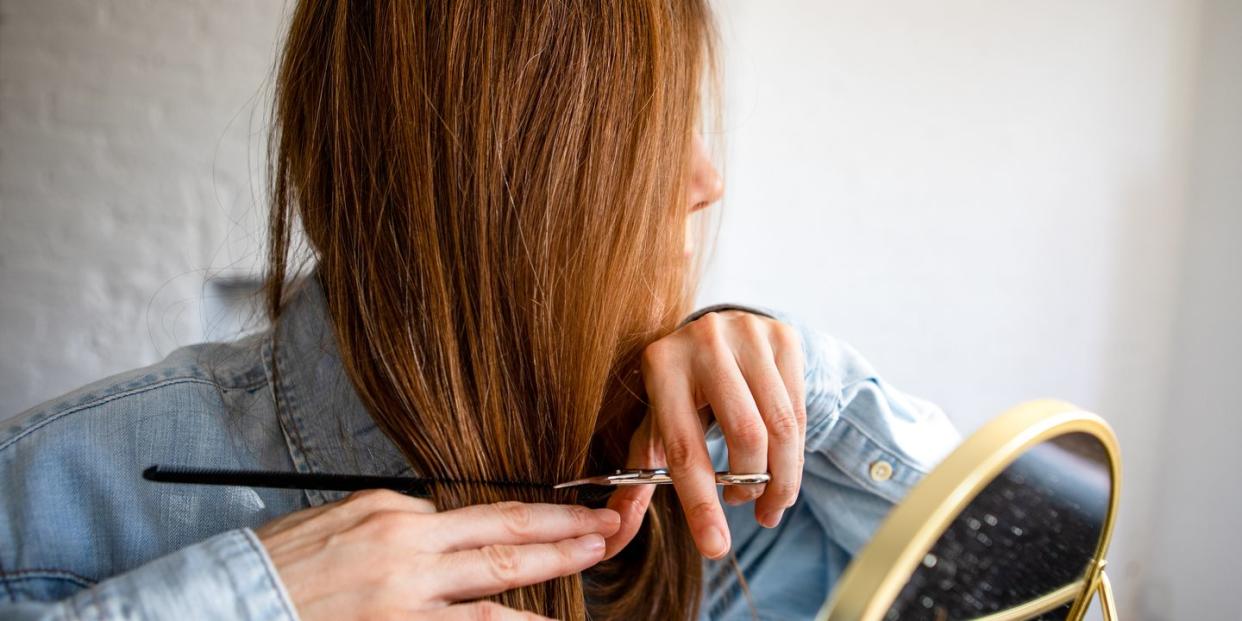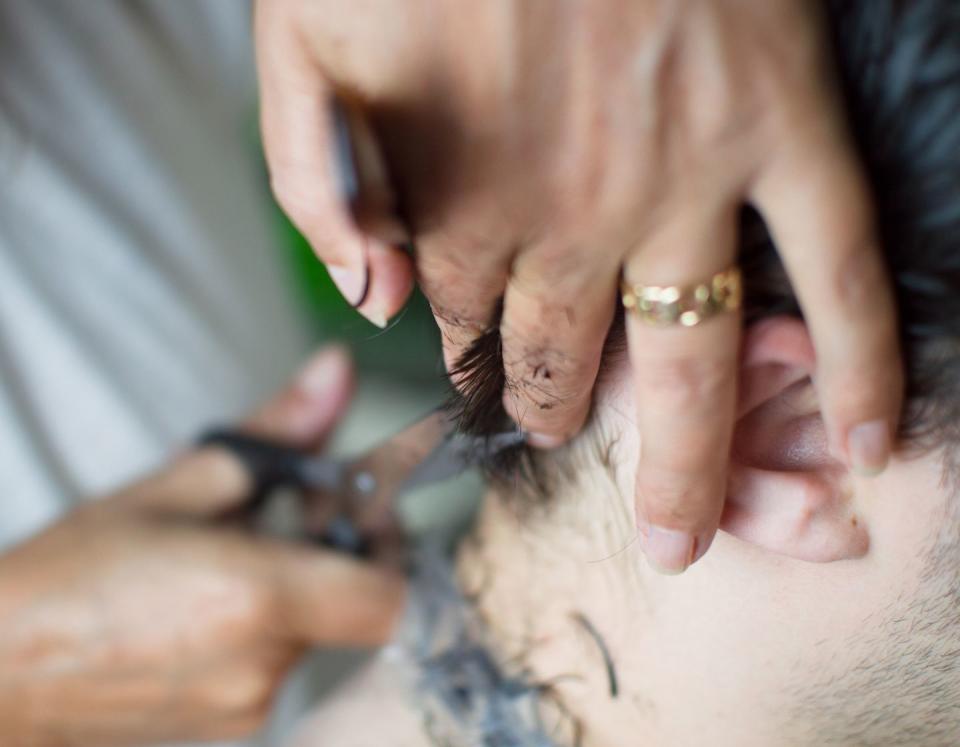How to cut your own hair at home during lockdown – an expert guide

With the UK in its second month of lockdown, for most of us, this has meant having to unexpectedly social distance from our hair dresser, and miss our usual hair appointment. While the easing of some lockdown measures has begun, it is still unclear when we will be able to return to the salon. So, unless you are quarantining with a hairdresser, you might be understandably starting to get a little desperate.
Cutting hair is complicated and takes years of training, which is why most stylists are advising their clients to side-step the scissors and wait until the pandemic is over. But if you simply cannot wait, here is what you need to know: from trimming a fringe to snipping split ends and shaving your head, we asked the experts how to cut your own hair at home.
Preparation
What preparation should I do beforehand? Avoid diving into a haircut without sufficient preparations. The process starts with clean hair, so make sure to shampoo and condition your hair beforehand. It’s best to cut your hair when it’s dry, suggests Jamie Stevens, hairdresser and owner of Jamie Stevens Hair. ‘Wet hair will change shape and also become shorter when it dries,’ he explains.
Before you think about making the first snip, ensure that your mirror is a comfortable height and you have a plan in mind. ‘You shouldn’t be bending or leaning to see your reflection,’ says Stevens. ‘Watch as many YouTube tutorials as you can to become familiar with what you’re aiming to do before you start.’
And if you’re cutting someone else’s hair? ‘Try putting a chair in the bath and having them sit there while you play hairdresser,’ suggests stylist and Moroccan Oil educator Laura Bell. ‘It’ll make tidying up a whole lot easier when you’re finished.’
Equipment
What equipment will I need? Hands off the kitchen scissors. ‘They are usually too big for haircuts,’ says Adam Jones, hair stylist at Live True London. ‘Use the thinnest scissors you can find, so that you can control the amount of hair being cut.’
Make sure your scissors are really sharp, says Stevens. ‘You can buy proper hairdressing scissors online,’ he says. ‘At a push, nail scissors will do for a fringe trim.’
To cut longer hair, you’ll need a paddle brush, sectioning clips and a cutting comb. For short hair, you’ll need clippers. ‘Also, get yourself some thinning scissors as these will help to soften hard uneven lines in the hair,’ he adds.
How to cut your own hair
Do
Hold your breath during detailed snips. Yes, really. “You’ll need a super steady hand for the trickier bits,’ says Bell. ‘A good tip is to temporarily hold your breath while you’re doing these, as it’ll steady your hand and give you more control.’
Err on the side of caution. Cut less than you think. ‘When you’ve decided where to cut your hair, go a bit longer,’ says Stevens. ‘You can always cut more off, but you can’t put it back.’
Approach the cut in segments. ‘Section your hair first from the front and the back, and then split your back sections into two new sections – from ear to ear,’ says Jones. ‘Less hair is involved so it will be easier to manage. Make sure you cut clean lines and cut the same amount on each section.’

Don’t
Colour your hair. ‘Cut hair will grow back,’ says Jones. ‘Box colour can damage the hair or alter the colour to a point that would interfere with professional products.’ This could make your first post-lockdown salon visit a rather expensive one.
Cut wet hair. ‘It stretches more easily and you can end up with it being shorter than you want, or uneven because of the tension when you pull it between your fingers,’ says Stevens.
Go for a restyle. ‘A trim is the only viable cut to do on yourself, as you can follow the lines your hairdresser has put in,’ says Stevens. ‘Don’t cut in a fringe if you don’t have one already, don’t try anything technical – like a bob. Anything that involves cutting the back of your hair is a non starter.’
How to trim your ends
Part your hair centrally across the shoulders, says Stevens. ‘Split the hair into two sections and pull forwards over your shoulders,’ he says. ‘On one side, pull the length of the hair straight between two fingers with good tension – don’t pull at an angle’. Using the point of the scissors, snip into the ends. ‘Keep your head straight, then do the other side and check they match,’ he adds.
How to cut your own fringe
Want to cut your own bangs? If you have a fringe already, use a ‘point cutting’ technique, says Stevens. ‘This is where you hold the scissors vertically and snip into the ends. Don’t, under any circumstances, try and cut horizontally across your fringe.’
Cut only half a centimetre at a time, so you have control over the length, adds Jones. ‘When the cut is finished, style your hair fully and do a final check to see if the hair is all connected fully. If not, make the adjustment needed.’
How to cut your own layers
What about if you want to trim or cut layers into longer hair? While this requires a little more skill than a straight cut, you can cut graduated layers into your hair at home by making angled cuts into the length.
Start by trimming modestly, you can always cut off more later if you like the shape. Also, if you're cutting your hair wet, keep in mind it will look shorter when it is dry.
How to cut men’s hair
There are many different ways of cutting men’s hair. ‘I’d say the main ones are clipper haircuts – mainly using different guards to create different lengths – scissor-over-comb cuts, which can be softer and more textured, and all-finger cutting, which is mainly used for longer styles,’ says Stevens. The easiest option is to use clippers. Remember, the lower the number, the shorter the cut.
‘Make sure that the guard is locked safely onto the machine,’ says Jones. ‘Use the longer guard first and work on the sides. Repeat the same movement with shorter guards, stopping roughly 1cm lower each time.’ Repeat the same at the back – while holding a mirror, if you’re cutting it yourself – and then snip the tips on the top before connecting with the sides and back.
How to shave your head
Shaving your head might seem straightforward, but it can easily go wrong. Where you start doesn’t matter – what’s important is technique. ‘You must make sure that you use the same grade all over and that you exert the same pressure all over too,’ says Jones. ‘Go over the same section in a perpendicular way so that all small hair is cut evenly.’
Last updated: 15-05-2020
You Might Also Like


